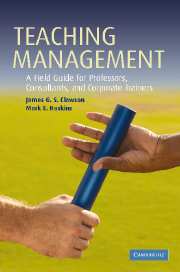Book contents
- Frontmatter
- Contents
- List of figures
- Sources to chapter quotations
- Why this book on teaching management?
- 1 Fundamental elements in teaching
- 2 Levels of learning: one, two, and three
- 3 Adult learning theory: it matters
- 4 Planning a course: trips and tips
- 5 Planning a class: no detail is too small
- 6 Lecturing: the possibilities and the perils
- 7 Managing discussions
- 8 Case method: fostering multidimensional learning
- 9 Role-playing
- 10 Case writing: crafting a vehicle of interest and impact
- 11 Case teaching notes: getting from here to there
- 12 Action learning
- 13 Experiential methods
- 14 Enhancing the conversation: audiovisual tools and techniques
- 15 Executive education: contributing to organizational competitive advantage
- 16 Using technology to teach management
- 17 Counseling students
- 18 Evaluating students: the twin tasks of certification and development
- 19 Teaching evaluations: feedback that can help and hurt
- 20 Research presentations
- 21 Managing a degree program: behind the ‘glory’
- 22 Managing a nondegree client program: an overview
- 23 Dealing with the press
- 24 Managing yourself and your time
- 25 Using teaching portfolios and course portfolios
- 26 Conclusion: is this on the exam?
- Index
10 - Case writing: crafting a vehicle of interest and impact
Published online by Cambridge University Press: 25 February 2010
- Frontmatter
- Contents
- List of figures
- Sources to chapter quotations
- Why this book on teaching management?
- 1 Fundamental elements in teaching
- 2 Levels of learning: one, two, and three
- 3 Adult learning theory: it matters
- 4 Planning a course: trips and tips
- 5 Planning a class: no detail is too small
- 6 Lecturing: the possibilities and the perils
- 7 Managing discussions
- 8 Case method: fostering multidimensional learning
- 9 Role-playing
- 10 Case writing: crafting a vehicle of interest and impact
- 11 Case teaching notes: getting from here to there
- 12 Action learning
- 13 Experiential methods
- 14 Enhancing the conversation: audiovisual tools and techniques
- 15 Executive education: contributing to organizational competitive advantage
- 16 Using technology to teach management
- 17 Counseling students
- 18 Evaluating students: the twin tasks of certification and development
- 19 Teaching evaluations: feedback that can help and hurt
- 20 Research presentations
- 21 Managing a degree program: behind the ‘glory’
- 22 Managing a nondegree client program: an overview
- 23 Dealing with the press
- 24 Managing yourself and your time
- 25 Using teaching portfolios and course portfolios
- 26 Conclusion: is this on the exam?
- Index
Summary
We ought to be able to learn some things secondhand. There is not enough time for us to make all the mistakes ourselves.
– Harriet HallLate at night, Lt. Col. Hal Moore pores over the military history of the French in Vietnam. Soon, he will lead the US Army's 7th Cavalry into battle there. In the movie We Were Soldiers, Moore (played by Mel Gibson) sits at a desk littered with open books. The camera zooms in on one particular book, opened to the battlefield pictures of a massacred French army unit. Moore is making terse, blunt notes as to the mistakes he believes the French made. The unspoken line of the moment is, “I will not make the same mistakes!” Later, we see Lt. Col. Moore training his men in battlefield simulations with as much noise, chaos, and the need for on-the-spot decisions as he can create – all to prepare them for what is to come.
Such is the intent of case method instruction, and in particular, case writing. Indeed, one of the most important aspects of case writing is the development and use of provocative scenarios that enable students to learn, using Harriet Hall's term, “secondhand.” Done well, some good cases are useful for several years, and some great cases for many years. Consequently, the questions that arise are: “Should I consider writing a case?” “Where can I find good cases?” “Where can I find promising case leads?” and “How do I craft effective, enduring cases?”
- Type
- Chapter
- Information
- Teaching ManagementA Field Guide for Professors, Consultants, and Corporate Trainers, pp. 154 - 176Publisher: Cambridge University PressPrint publication year: 2006

